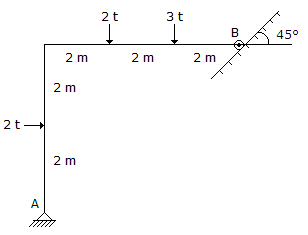Civil Engineering :: Applied Mechanics
-
A weight of 100 kg is supported by a string whose ends are attached to pegs A and B at the same level shown in below figure. The tension in the string is

-
A train weighing 196 tonnes experiences a frictional resistance of 5 \( \frac { 1 1} {2 2 }\)per tonne. The speed of the train at the top of a down gradient 1 in 78.4 is 36 km/hour. The speed of the train after running 1 km down the slope, is
-
The reaction at the support B of the beam shown in below figure is

-
A stone is whirled in a vertical circle, the tension in the string, is maximum
-
If the velocity of projection is 4 m/sec and the angle of projection is 뱡, the maximum height of the projectile from a horizontal plane, is
-
If a spherical body is symmetrical about its perpendicular axes, the moment of inertia of the body about an axis passing through its centre of gravity as given by Routh's rule is obtained by dividing the product of the mass and the sum of the squares of two semi-axes by n where n is
-
The angle of projection for a range is equal to the distance through which the particle would have fallen in order to acquire a velocity equal to the velocity of projection, will be
-
A particle executes a simple harmonic motion. While passing through the mean position, the particle possesses
-
A body of weight w placed on an inclined plane is acted upon by a force P parallel to the plane which causes the body just to move up the plane. If the angle of inclination of the plane is θ and angle of friction is φ, the minimum value of P, is
-
Varigon's theorem of moments states
|
A.
arithmetical sum of the moments of two forces about any point, is equal to the moments of their resultant about that point |
|
B.
algebraic sum of the moments of two forces about any point, is equal to the moment of their resultant about that point |
|
C.
arithmetical sum of the moments of the forces about any point in their plane, is equal to the moment of their resultant about that point |
|
D.
algebraic sum of the moments of the forces about any point in their plane, is equal to the moment of their resulant about that point. |


 Whatsapp
Whatsapp
 Facebook
Facebook

